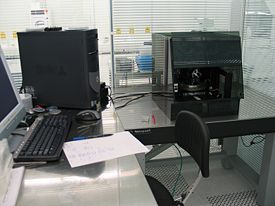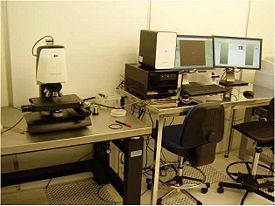Specific Process Knowledge/Characterization/Profiler: Difference between revisions
| Line 79: | Line 79: | ||
!style="background:silver; color:black;" align="left"|Purpose | !style="background:silver; color:black;" align="left"|Purpose | ||
|style="background:LightGrey; color:black"|3D topographic imaging of surfaces.||style="background:WhiteSmoke; color:black"| | |style="background:LightGrey; color:black"|3D topographic imaging of surfaces.||style="background:WhiteSmoke; color:black"| | ||
* | *3D imaging of surface | ||
* | *Roughness measurements | ||
* | *Step height measurement | ||
*3D topographic measurements | |||
* | *Thin film thickness measurement in small spots (down to 4µm) | ||
* | |||
|- | |- | ||
!style="background:silver; color:black;" align="left"|Posibilities | !style="background:silver; color:black;" align="left"|Posibilities | ||
| Line 94: | Line 92: | ||
*PSI (Phase Shift Interferometry) | *PSI (Phase Shift Interferometry) | ||
*VSI (Vertical Scanning Interferometry) | *VSI (Vertical Scanning Interferometry) | ||
*high resolution thin film thickness measurement | *high resolution thin film thickness measurement using reflectrometry | ||
* | *wafer mapping | ||
|- | |- | ||
!style="background:silver; color:black" align="left"|Performance | !style="background:silver; color:black" align="left"|Performance | ||
Revision as of 11:57, 31 May 2012
Dektak 8 stylus profiler

Dektak 8 stylus profiler is a product of Veeco Instruments. It is usable for profiling surfaces of samples with structures in the micrometer range. It can measure in a specific point found with help from high magnification video cameras or it can be programmed to measure several points defined with respect to some deskew points. It can also be used for stress measurements of thin films by measuring the wafer bow.
To get some product information and some tips and tricks from the vendor take a look at Veeco's homepage [1]
A rough overview of the performance of Dektak 8 stylus profiler
| Purpose | Profiler for measuring micro structures. |
|
|---|---|---|
| Performance | Scan range xy |
Line scan x: 50 µm to 100 mm |
| Scan range z |
50 Å to 1 mm | |
| Resolution xy |
down to 0.067 µm | |
| Resolution z |
1Å, 10Å, 40Å or 160Å (for ranges 65kÅ, 655 kÅ, 2620 kÅ and 1mm respectively) | |
| Max. scan depth as a function of trench width W |
1.2(W[µm]-5µm) | |
| Hardware settings | Tip radius |
|
| Substrates | Substrate size |
|
| Substrate material allowed |
|
Optical Profiler (Sensofar)

PLu Neox 3D Optical Profiler (from Sensofar)has a dual-technology sensor head that combines confocal and interferometry techniques as well as thick and thin film measurement capabilities.
The neox sensor head provides standard microscope imaging, confocal imaging, confocal profiling, PSI (Phase Shift Interferometry), VSI (Vertical Scanning Interferometry) and high resolution thin film thickness measurement on a single instrument.
The main purpose is 3D topographic imaging of surfaces, Step height measurements in smaller trenches/holes than can be obtained with standard stylus method, roughness measurements with larger FOV than the AFM, but less horisontal resolution.
A rough overview of the performance of the Optical Profiler (Sensofar)
| Purpose | 3D topographic imaging of surfaces. |
|
|---|---|---|
| Posibilities | Confocal and interferometric profiling and reflectometry |
|
| Performance | Scan range xy |
Line scan x: 50 µm to 100 mm |
| Scan range z |
50 Å to 1 mm | |
| Resolution xy |
down to 0.067 µm | |
| Resolution z |
1Å, 10Å, 40Å or 160Å (for ranges 65kÅ, 655 kÅ, 2620 kÅ and 1mm respectively) | |
| Max. scan depth as a function of trench width W |
1.2(W[µm]-5µm) | |
| Hardware settings | Tip radius |
|
| Substrates | Substrate size |
|
| Substrate material allowed |
|
Comparing the profilers
Take a look at the topographic measurement page.
